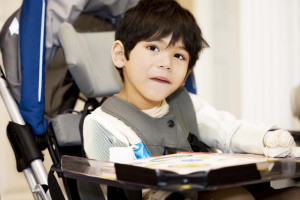
Most of us understand that our bodies are full of vessels known as nerves. These interact with the brain and allow us to feel, control the body, and more. Nerves are extremely complex and can surprise us with how far they extend out into the body.
For example, the brachial plexus nerves are a group of five different nerves responsible for the upper limbs, the armpits, and the back of the neck. Should any of them be harmed, damaged or destroyed, certain functions within these areas would be impeded or interrupted too. The most common way this would manifest is through paralysis.
In the case the condition is known as Klumpke's palsy, it is harm to the two lowest of the five brachial plexus nerves that lead to paralysis in the hand and forearm (and sometimes the flexors controlling the wrist). While it is rare, it does occur, and it does happen to babies.
How Does Klumpke's Palsy Occur in Children?
Generally, there are a few ways that injury during birth might occur and lead to a condition like Klumpke's palsy. Sometimes it can be that the baby's size is just too large for the birth canal, and this might force the infant into a harmful and unnatural position during birth. This might effectively destroy or damage the nerves and lead to this form of palsy.
The baby may also present in an unusual position with the face pointing downward and this angle can cause damage to the nerves. The baby's shoulder might also get caught on the pubic bone during delivery, and again this can lead to Klempke's palsy.
Unfortunately, doctors and medical professionals might cause the condition by pulling on a baby in the wrong way, and when that baby is already in an unusual position as well.
The type of nerve damage might vary because it can happen in a number of different ways. This makes it possible for Klempke's palsy to be mild to severe. Nerves might be stretched but not torn, sustaining damage that leads to mild paralysis or severe damage. Nerves can be torn, but heal; they can be ruptured, but remain connected. They can be completely torn from the spine as well.
The Symptoms
Obviously, this range of possible brachial nerve damage reveals that there are a host of symptoms that point to Klumpke's palsy as a possible diagnosis. In some cases, it is diminished sensation in the limbs that are the only symptoms. However, in more severe cases a baby may be entirely unable to move the hands or forearms. The hands might also be bent into a claw-like shape due to harming the nerves in the wrist flexors.
Treating Klumpke's Palsy
Interestingly enough, there are also several ways that treatment can be administered. One is a period of watchful waiting since some nerves can heal over time. Sometimes there is scar tissue that causes a lingering, but mild paralysis, and sometimes the problem is alleviated. If this is not a viable solution, surgical repair of the nerve is necessary to provide the infant with the use of the hands and arms.
Physical therapy is part of any child's recovery, regardless of how mild their Klumpke's palsy might have been. This ensures that muscle tone remains while the tissue heals. It can take from a few months to several years for a baby to recover, but the rates are extremely promising, with almost all children regaining full use of the limbs.
While it may be unavoidable, it may be a condition caused by birth injury. If you feel this is the case, get in touch with a birth injury lawyer to discuss the matter.
 Most of us understand that our bodies are full of vessels known as nerves. These interact with the brain and allow us to feel, control the body, and more. Nerves are extremely complex and can surprise us with how far they extend out into the body.
For example, the brachial plexus nerves are a group of five different nerves responsible for the upper limbs, the armpits, and the back of the neck. Should any of them be harmed, damaged or destroyed, certain functions within these areas would be impeded or interrupted too. The most common way this would manifest is through paralysis.
In the case the condition is known as Klumpke's palsy, it is harm to the two lowest of the five brachial plexus nerves that lead to paralysis in the hand and forearm (and sometimes the flexors controlling the wrist). While it is rare, it does occur, and it does happen to babies.
Most of us understand that our bodies are full of vessels known as nerves. These interact with the brain and allow us to feel, control the body, and more. Nerves are extremely complex and can surprise us with how far they extend out into the body.
For example, the brachial plexus nerves are a group of five different nerves responsible for the upper limbs, the armpits, and the back of the neck. Should any of them be harmed, damaged or destroyed, certain functions within these areas would be impeded or interrupted too. The most common way this would manifest is through paralysis.
In the case the condition is known as Klumpke's palsy, it is harm to the two lowest of the five brachial plexus nerves that lead to paralysis in the hand and forearm (and sometimes the flexors controlling the wrist). While it is rare, it does occur, and it does happen to babies.
